
Kuskovo
Encyclopedia
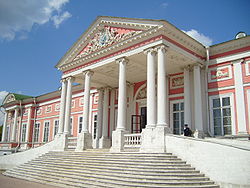
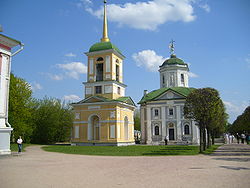
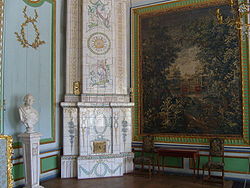
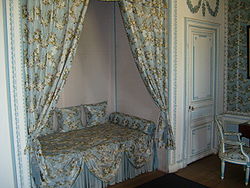


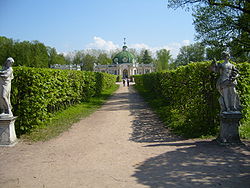
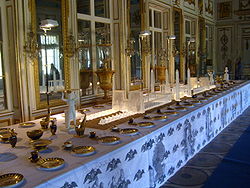
Sheremetev
The Sheremetev family was one of the wealthiest and most influential noble families of Russia.The family held many high commanding ranks in the Russian military, governorships and eventually the rank of Count of the Russian Empire...
family. Built in the mid-18th century, it was originally situated several miles to the east of Moscow but now is part of the East District of the city. It was one of the first great summer country estates of the Russian nobility, and one of the few near Moscow still preserved. Today the estate is the home of the Russian State Museum of Ceramics, and the park is a favourite place of recreation for Muscovites.
History
In the 17th century Kuskovo became the property of Boris Petrovich SheremetevBoris Petrovich Sheremetev
Boris Petrovich Sheremetev was created the first Russian count in 1706, and was also a diplomat and general field marshal during the Great Northern War. His children included Pyotr Sheremetev and Natalia Sheremeteva....
(1652–1719), a Russian Field Marshal under Czar Peter the Great, who led the Russian Army in the victory over the Swedes at the Battle of Poltava
Battle of Poltava
The Battle of Poltava on 27 June 1709 was the decisive victory of Peter I of Russia over the Swedish forces under Field Marshal Carl Gustav Rehnskiöld in one of the battles of the Great Northern War. It is widely believed to have been the beginning of Sweden's decline as a Great Power; the...
(1707) in the Great Northern War
Great Northern War
The Great Northern War was a conflict in which a coalition led by the Tsardom of Russia successfully contested the supremacy of the Swedish Empire in northern Central Europe and Eastern Europe. The initial leaders of the anti-Swedish alliance were Peter I the Great of Russia, Frederick IV of...
. There was already a wooden church on the site, a house and several pond.
The palace was constructed by his son Petr Borisovich Sheremetev
Petr Borisovich Sheremetev
Pyotr Borisovich Sheremetev was a Russian nobleman and courtier, the richest man in Russia aside from the tsar; he was the son of Boris Sheremetev....
(1713–1787). Count Sheremetev was one of the richest men in Russia, close to the court and a patron of the arts. He built Kuskovo at approximately the same time that he built a city palace on the banks of the Fontanka River in St. Petersburg. When he decided to build a palace at Kuskovo, he ordered that it be larger and more beautiful than the estates of other nobles, and equal to any residence of the Czars. Since it was less than a day's journey from the center of Moscow, it was not designed to accommodate overnight guests, nor for agriculture or any other practical purpose, but purely as a place for entertainment, ceremony and festivities.
Construction was carried out between the 1730s and the 1790s on a site of over three hundred hectares. The earliest surviving structure is the Saviour church, on the site of the old wooden church, built in 1737-39 in a Petrine baroque
Petrine Baroque
Petrine Baroque is a name applied by art historians to a style of Baroque architecture and decoration favoured by Peter the Great and employed to design buildings in the newly-founded Russian capital, Saint Petersburg, under this monarch and his immediate successors.Unlike contemporaneous Naryshkin...
style and decorated with marble statues. The neoclassical
Neoclassicism
Neoclassicism is the name given to Western movements in the decorative and visual arts, literature, theatre, music, and architecture that draw inspiration from the "classical" art and culture of Ancient Greece or Ancient Rome...
bell-tower was added later, in 1792.
The Dutch House was constructed between 1749 and 1751 by architect Y.I. Kologrivov, who then enlarged the pond into a lake and laid out the park and canals. After the death of Kologrivov in 1754, the construction of the palace was begun by the young architect Fiodor I. Argunov, who had designed the grotto and the belvedere by the canal in the eastern part of the park. When Fiodor Argunov became occupied with the construction of the Sheremetev house on the Fontanka in St. Petersburg, the task of designing the palace was given to the famous Moscow architect Karl Blank
Karl Blank
Karl Blank was a Russian architect, notable as one of the last practitioners of Baroque architecture and the first Moscow architect to build early neoclassical buildings. His surviving, undisputed legacy consists of three baroque churches and Moscow Orphanage...
. The construction of the house occupied the 1760s. The neoclassical facade, attributed to the French architect Charles de Wailly
Charles De Wailly
Charles De Wailly was a French architect and urbanist, and furniture designer, one of the principals in the Neoclassical revival of the Antique. His major work was the Théâtre de l'Odéon for the Comédie-Française...
, was added in 1774 after the son of the owner returned from Paris 1773.
The twenty-six rooms of the palace were designed for entertaining and impressing guests on state occasions. Count Sheremetev entertained in a grand style; his outdoor entertainments in the park attracted as many twenty-five thousand guests. Entertainments included his a famous theater and orchestra with serf actors. The estate was visited by Empress Catherine II in 1775; an obelisk in the park marks the event.
By the end of the 18th century, the estate went into a decline. It was badly damaged during the French invasion in 1812. In the 1830s, the serf theater was torn down. After the abolition of serfdom in 1861, parcels of land were divided up and rented out. In the 19th century much of the furniture was moved to the city residences of the Shermetevs in Moscow and St. Petersburg.
After the 1917 Revolution, the estate was nationalized. In 1919 the palace was turned into a small museum of natural history. Ten years later it became the home of the state museum of porcelain, which had been founded in 1918-20 on Podossensky Street in Moscow. It housed the nationalized collections of Russian art collectors A. Morozov
Morozov
Morozov may refer to:*Morozov , a lunar crater*Morozov , people with the surname Morozov*Nikolai Alexandrovich Morozov, a Russian revolutionary-See also:...
, L. Zoubalov, and Botkine. In 1932 it was renamed the State Museum of Ceramics.
The Palace of Kuskovo
The palace was designed in the new neoclassicalNeoclassical architecture
Neoclassical architecture was an architectural style produced by the neoclassical movement that began in the mid-18th century, manifested both in its details as a reaction against the Rococo style of naturalistic ornament, and in its architectural formulas as an outgrowth of some classicizing...
style, then becoming popular for state buildings in St. Petersburg and Moscow. The exterior was made of wooden planks, which were plastered and painted in soft pastel colors. The palace looked out onto a court of honor, formed by the palace, the church and the large lake. The six-column portico at the front of the house was designed with a ramp so that carriages with as many as eight horses could come directly to the front door. When the carriage arrived, servants would rush out the front doors and hold the horses while the guests descended.
Inside the palace on the western end of the building, were twelve large state rooms, and two smaller ensembles of rooms for residential use.
- The vestibule at the front entrance was walled with plaster painted to resemble marble, with vases in niches designed by Johannes Justus.
- The Reception Room had both an ornate European fireplace and a Russian oven decorated with colored tiles, showing the two artistic traditions in Russia at the time.
- The Tapestry Room was the second reception room. It was deocated with 17th century FlemishFlandersFlanders is the community of the Flemings but also one of the institutions in Belgium, and a geographical region located in parts of present-day Belgium, France and the Netherlands. "Flanders" can also refer to the northern part of Belgium that contains Brussels, Bruges, Ghent and Antwerp...
tapestries depicting parks and gardens. Between the tapestries, the windows looked out onto the lake and garden of the estate.
- The State Bedroom Though it has a bed, the state bedroom was never used as a bedroom, but rather as a formal reception room, to impress the guests with the owner's taste.
- the Cabinet-Bureau was the personal office of the Count, decorated with Dutch style-oak paneling with carved picture motifs, in the style of Peter the Great.
- Everyday Bedroom was designed for rest. It had a marble-faced fireplace with inserted paintings by French artists, and portraits of the Sheremetev family.
- The Dancing Hall or hall of mirrors was the largest and most decorated room in the house, with a painted ceiling and mirror-covered walls in white and gold.
- The Billiards Room features a large billiardsBilliardsCue sports , also known as billiard sports, are a wide variety of games of skill generally played with a cue stick which is used to strike billiard balls, moving them around a cloth-covered billiards table bounded by rubber .Historically, the umbrella term was billiards...
table made in England in the 18th century.
- The Dining Room The paintings and decoration of the dining room stressed the long history and glory of the Sheremetev family.
The Park of Kuskovo
The park of Kuskovo was created between 1750 and 1780 as a formal Garden à la françaiseGarden à la française
The French formal garden, also called jardin à la française, is a style of garden based on symmetry and the principle of imposing order over nature. It reached its apogee in the 17th century with the creation of the Gardens of Versailles, designed for Louis XIV by the landscape architect André Le...
, with large ornamental parterres of flowers, carefully trimmed hedges, and alleys which met at either right or diagonal angles, and were ornamented with statues, and lined with either rows of trees trimmed into spheres, large vases; orange trees; or myrtle trees trimmed into cones. Eight park alleys converge in a single point, where the circular Hermitage pavilion (1764–77) now stands. Count Sheremetev spent most of his time in the Hermitage, coming to the Palace only for formal occasions and holidays.
In the 1770s, following the changing tastes of the period, a second park in the style of an English landscape garden, no longer existing, was created to the north of the French park. This park presented an idealized version of nature, with winding paths, tunnels of greenery, picturesque groves of trees, lawns, and pavilions. Only the Hermitage remains from this part of the park.
The Grotto
The grottoGrotto
A grotto is any type of natural or artificial cave that is associated with modern, historic or prehistoric use by humans. When it is not an artificial garden feature, a grotto is often a small cave near water and often flooded or liable to flood at high tide...
was constructed between 1755 and 1761 by the architect F. Afgounov, and was intended to represent the palace of the King of the Seas. It was placed next to a large pond, which reflected its imposing facade and dome. Inside rows of niches were filled with statues of Venus
Venus (mythology)
Venus is a Roman goddess principally associated with love, beauty, sex,sexual seduction and fertility, who played a key role in many Roman religious festivals and myths...
, Diana
Diana (mythology)
In Roman mythology, Diana was the goddess of the hunt and moon and birthing, being associated with wild animals and woodland, and having the power to talk to and control animals. She was equated with the Greek goddess Artemis, though she had an independent origin in Italy...
, Ceres, Flore, Juno
Juno (mythology)
Juno is an ancient Roman goddess, the protector and special counselor of the state. She is a daughter of Saturn and sister of the chief god Jupiter and the mother of Mars and Vulcan. Juno also looked after the women of Rome. Her Greek equivalent is Hera...
and Jupiter
Jupiter (mythology)
In ancient Roman religion and myth, Jupiter or Jove is the king of the gods, and the god of the sky and thunder. He is the equivalent of Zeus in the Greek pantheon....
. The windows were covered with iron grills forged by serf artisans look like strands of seaweed. The interior space, under dome, is meant to be the throne room of Neptune, crusted with seashells (1771-1775.) The grotto is one of the few 18th century grottos still preserving its original decoration.
The Dutch House
A traditional brick Dutch house was constructed in the 1750s on a small pond near the Palace. the house has kitchen on the ground floor decorated from floor to ceiling with tiles from DelftDelft
Delft is a city and municipality in the province of South Holland , the Netherlands. It is located between Rotterdam and The Hague....
. Meals were served to guests in th kitchen, though they were actually prepared at another kitchen in the woods nearby and carried by servants to the house. The upper floor is furnished with simple, solid Dutch furniture and highly decorated with Delft tiles.
The Orangerie
The orangerie (1761–1764) was designed by F. Argounov. It was not used as orangerie- the lemons, oranges and pineapples served the guests at Kuskovo were actually grown in greenhouses outside the park. Rather, it was used as a large banquet hall for guests. In the 1960s, it was turned into an exhibit hall for the collections of porcelain.This palace houses the most precious collection of Western porcelain
Porcelain
Porcelain is a ceramic material made by heating raw materials, generally including clay in the form of kaolin, in a kiln to temperatures between and...
in Eastern Europe, which had been collected by several generations of the Sheremetev family. In 1919 the palace was nationalized, and it was declared the State Museum of Ceramics
Ceramics (art)
In art history, ceramics and ceramic art mean art objects such as figures, tiles, and tableware made from clay and other raw materials by the process of pottery. Some ceramic products are regarded as fine art, while others are regarded as decorative, industrial or applied art objects, or as...
twenty years later.
The State Museum of Ceramics
The museum in the Orangerie contains collections of fine porcelain assembled by Russian merchants and Empress Maria FedorovnaMaria Fedorovna
Maria Feodorovna was the name taken by two distinct Russian empresses of originally German and Danish ethnicity:*Maria Feodorovna , daughter of Frederick II Eugene, Duke of Württemberg; wife of Emperor Paul I of Russia*Maria Feodorovna , daughter of Christian IX of Denmark; wife of Emperor...
before the Russian Revolution. The major sections are:
- German porcelain of the 18th and 19th centuries, particularly from the royal porcelain works at MeissenMeissenMeissen is a town of approximately 30,000 about northwest of Dresden on both banks of the Elbe river in the Free State of Saxony, in eastern Germany. Meissen is the home of Meissen porcelain, the Albrechtsburg castle, the Gothic Meissen Cathedral and the Meissen Frauenkirche...
- English porcelain from Chelsea and Josiah Wedgewood.
- French porcelain from the 18th century from manufacture royale of SèvresSèvresSèvres is a commune in the southwestern suburbs of Paris, France. It is located from the centre of Paris.The town is known for its porcelain manufacture, the Manufacture nationale de Sèvres, making the famous Sèvres porcelain, as well as being the location of the International Bureau of Weights...
. One highlight of the collection is the Egyptian service, given to Napoleon Bonaparte in 1798 to commemorate his Egyptian campaign, and given by Napoleon to Czar Alexander IAlexander I of RussiaAlexander I of Russia , served as Emperor of Russia from 23 March 1801 to 1 December 1825 and the first Russian King of Poland from 1815 to 1825. He was also the first Russian Grand Duke of Finland and Lithuania....
at Tilsit in 1807. - Danish porcelain of the 18th and 19th century.
- Russian and Soviet porcelain of the 18th, 19th and 20th century. The collection of porcelain on revolutionary themes from the early Soviet period is particularly notable.

